Bird Cage Companionship: Understanding Avian Bonds
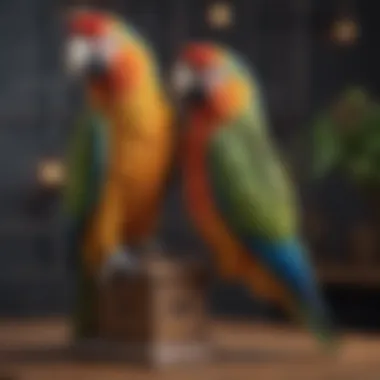
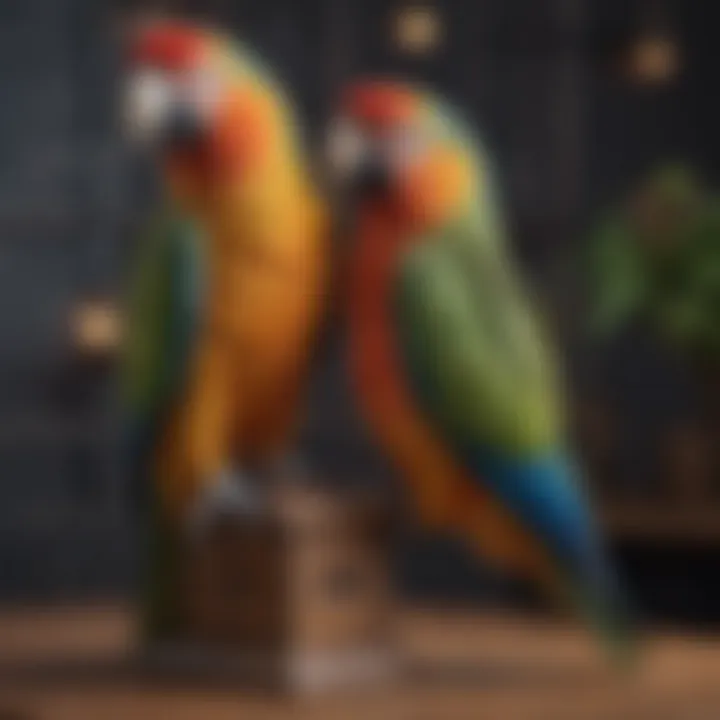
Intro
In the space where companionship thrives, the bond between pet birds and their owners often represents a delicate equilibrium of freedom and captivity. With every chirp and flutter, the intriguing dynamics of this relationship unfold. Like two dancers in a well-rehearsed routine, both parties have roles that affect one another. Understanding the nuances of this partnership not only enriches the lives of our feathered friends but also enhances our experience as caregivers.
The metaphor of a bird cage signifies more than just a physical structure; it embodies the habitat shared by these unique animals and their human companions, reflecting a profound coexistence. The exploration of this relationship encompasses myriad responsibilities and joys of bird ownership, like learning the delicate balance between allowing freedom and establishing boundaries. This article aims to provide much-needed insights into the multifaceted world of avian companionship, showcasing how to cultivate an environment where pets feel at home.
By addressing psychological, social, and environmental aspects, it is possible to craft an enriching experience for both avian buddies and their keepers. So, let’s ruffle those feathers and dive into the world of care tips, behavioral insights, nutrition guides, wellness checks, and activities designed to keep that bond soaring high.
Care Tips
Taking care of a pet bird requires commitment and an understanding of their specific needs. Creating a routine is crucial to their well-being. Starting with daily care, let's take a closer look at some fundamental aspects.
Daily Care Routines
Birds thrive on consistency. Setting a daily regimen that includes feeding, cleaning, and handling time can significantly impact their health and happiness.
- Feeding Schedule: Offer fresh food at the same time each day. A mix of pellets, fruits, and veggies serves as a balanced diet.
- Social Interaction: Spend at least an hour daily on interaction. Talking, gentle handling, or simply letting them observe you helps build trust.
- Hydration: Always provide fresh water. Clean the water dish daily to prevent any bacterial growth.
Cage Setup and Maintenance
The cage serves as a bird's home base. A proper setup is essential for comfort and security.
- Space Requirements: Choose a cage that provides ample room for movement. The bigger, the better!
- Bar Spacing: Ensure the bar spacing fits the size of your bird to prevent escape or injury.
- Location Matters: Place the cage in a busy area of the house but away from direct sunlight and drafts.
- Regular Cleaning: Clean the cage weekly, removing perches and food bowls. Use bird-safe cleaners to avoid harmful residues.
Hygiene and Cleaning Practices
Maintaining cleanliness is vital for preventing illness.
- Daily Checks: Monitor for droppings and stains. Spot clean as needed.
- Deep Cleaning: Monthly, take everything out, scrub surfaces, and replace perches regularly.
Seasonal Care Adjustments
Birds experience changes with seasons, requiring adaptations.
- Temperature Control: Ensure your bird is comfortable. Avoid placing cages near heating vents or air conditioning.
- Humidity Levels: Certain species might need additional humidity during winter months.
Behavioral Insights
Understanding your feathered friend’s behavior can turn confusion into clarity. Let’s decode some of their classic signals.
Understanding Bird Body Language
Birds communicate through physical cues more than words.
- Posture: Upright stance with ruffled feathers may indicate excitement or readiness to play.
- Head Bobbing: Commonly a sign of affection or excitement, especially in budgies.
- Wing Flapping: Indicates a desire to fly or play; this can also be a sign of excitement.
Common Behavioral Issues and Solutions
Birds, like any pet, may develop behavior problems.
- Over-Preening: Excessive grooming may signal boredom; offer toys or engage in more playtime.
- Screaming: While vocalization is natural, excessive noise can stem from loneliness. Spend more time with your bird or introduce companions.
Positive Reinforcement Techniques
Encouragement works wonders in creating good habits.
- Reward Good Behavior: Use treats to reinforce positive behaviors like stepping up on your finger or completing a trick.
- Consistent Commands: Always use the same command for behaviors you wish to encourage to avoid confusion.
Social Interaction Needs
Birds are social creatures craving interaction.
- Companionship: Consider having multiple birds, ensuring they are compatible species for a happier environment.
- Daily Attention: Even if you can't get another bird, daily interaction helps stave off loneliness.
"Birds with good social interaction are typically happier and healthier. They thrive in a home where they are engaged and understood."
Nutrition Guides
Proper nutrition is the cornerstone of a healthy pet bird. Let’s dive into their dietary needs.
Essential Diet Components
Knowing what to feed your bird is essential for longevity.
- Pellets: These should make up the bulk of your bird's diet.
- Fresh Fruits and Vegetables: Introduce a range of colors; these provide vital nutrients.
- Seeds as Treats: While birds love seeds, they should be given only in moderation due to high-fat content.
Safe and Toxic Foods
Some foods can be harmful or even deadly to birds.
- Safe Options: Oatmeal, carrots, and leafy greens like spinach are excellent choices.
- Avoid: Chocolate, avocado, and caffeine are toxic to birds.
Supplements and Treats
Using supplements can enhance their diet.
- Calcium Supplements: Essential for birds, particularly if they are laying eggs or are just growing.
- Occasional Treats: Offer nuts or seeds as a reward, but keep them limited.
Feeding Strategies for Different Species
Each bird has unique needs.
- Budgies: Require a high percentage of pellets, fresh veggies, and occasional seeds.
- Cockatiels: Prefer a diverse diet with fruit and veggies, along with pellets.
- Large Parrots: Thrive on a mix of seeds, pellets, and a variety of fresh foods.
Wellness and Health
Keeping your bird healthy requires vigilance and care.
Routine Health Checkups
Schedule vet visits annually for a health check to catch any issues early.


- Finding the Right Vet: Look for veterinarians who specialize in avian care.
- Regular Weigh-Ins: Monitor your bird's weight to ensure they are maintaining a healthy stature.
Identifying Symptoms of Illness
Early detection is key.
- Behavioral Changes: Watch for signs like lethargy or decreased appetite.
- Physical Signs: Fluffed feathers, discharge from the eyes or nose are signs to watch closely.
Preventative Care and Vaccinations
Vaccinations can prevent common avian diseases.
- Routine Vaccines: Ensure your bird is vaccinated; consult your vet about dog or cat vaccination discussions for optimal household harmony.
Mental and Emotional Well-being
Birds can experience stress and anxiety.
- Enrichment Activities: Having toys, mirrors, and interaction keeps their minds active and encourages positive behavior.
Enriching Activities
To keep your feathered friend engaged, incorporate various activities.
Toys and Playtime Ideas
Toys shouldn’t just clutter the cage, they should enhance quality of life.
- Variety of Toys: Rotate toys regularly to keep things fresh.
- DIY Toys: Use safe household items like paper towel rolls for climbing or shredding.
Training and Tricks
Teaching your bird can be rewarding.
- Simple Commands: Teach commands like "step up" or "come here" using treats as motivation.
- Fun Tricks: Gradually introduce tricks like wave or dance; this stimulates their mind.
Outdoor Activities and Interaction
Getting outside diversifies their experiences.
- Harness Training: Allows for safe exploration outside.
- Supervised Outdoor Time: Letting them explore a safe area under careful supervision can be exhilarating.
DIY Projects for Mental Stimulation
Crafting at home doesn’t just apply to people.
- Create Fun Perches: Use untreated wood to craft unique perches and stimulate your bird’s environment.
- Interactive Feeders: Experiment with food puzzles, challenging your bird while they eat.
Navigating the intricate world of avian companionship takes effort and dedication, but the rewards are plentiful. Birds can bring joy, laughter, and companionship, enhancing life for both parties involved. By investing time into understanding their needs and nurturing your bond, you’ll find that your relationship soars through every open door.
The Concept of Togetherness in Avian Care
When it comes to caring for pet birds, the concept of togetherness transcends mere companionship; it forms the crux of a fulfilling pet-owner relationship. Living with a bird is like holding a mirror to one’s emotions. For many, a pet bird is not just an animal in a cage but a partner in daily life, sharing the highs and lows of existence. The idea of ‘togetherness’ evokes a sense of mutual respect and understanding that enriches both the bird's and the owner's lives. In this section, we explore what togetherness truly means in the context of avian care, touching on how it affects the overall well-being of these captivating creatures and the commitment that it demands from their human companions.
The Metaphorical Bird Cage
Let's look at the cage—symbolic as it may be. This structure represents both freedom and limitation. It’s an interesting twist, really. The cage is where the bird often feels most secure, yet it is also what confines it. Ideally, a bird’s cage should not feel like a prison but rather a safe haven where it can express its individuality while being part of its human's life. It suggests a partnership where each participant’s needs are seen and heard.
To foster this togetherness, one ought to consider how this ‘cage’ can be made more than just walls and bars. It can be brimming with opportunities for play, exploration, and interaction. An enriched environment, filled with toys, perches, and spaces to fly, creates a reality where both owner and avian are engaged in a joyous experience. Essentially, it’s about crafting a habitat that feels like home for the bird, extending beyond the physical boundaries of the cage.
Understanding Avian Sentience
Delving into the idea of togetherness, we cannot overlook the sentience of birds. Understanding avian sentience is crucial in building a meaningful bond with these feathered companions. Birds possess complex emotional lives, often displaying affection, fear, curiosity, and even jealousy. Contrary to the outdated notion that birds are simple creatures, their ability to feel and react in nuanced ways underscores their depth.
Developing a connectedness with your bird hinges on recognizing these emotional layers. It’s essential to observe how your pet reacts to different stimuli, whether that be the sound of your voice, the rustling of newspaper, or the presence of another animal. Their vocalizations can convey a multitude of messages, from distress to excitement, and understanding this language opens doors for stronger relationships.
By creating an atmosphere that actively acknowledges and responds to a bird's feelings, the nurturing element of togetherness flourishes.
"True companionship signifies a shared experience where both parties feel valued and understood."
Incorporating these insights into your daily interactions can foster a bond that thrives on empathy and respect. Thus, the idea of togetherness in avian care shouldn’t be viewed as merely a shared space, but as a rich tapestry of emotional connection, understanding, and mutual respect.
Choosing the Right Companion Bird
Selecting the right companion bird is a significant step in establishing a bond that can flourish over the years. A pet bird is not just a simple addition to the household; they are unique beings, complete with their own personalities, quirks, and needs. Making the right choice can lead to a fulfilling companionship, while an incorrect decision can bring about various challenges. With this in mind, it's essential to delve deeply into some specific elements that can help guide potential bird owners in their selection process.
Assessing Personal Preferences
It's crucial for potential bird owners to look inward and assess what they truly desire in a feathered friend. Personal preferences vary widely and can shape the experience of having a bird. Do you want a bird that sings sweet melodies or one that talks back? Maybe you prefer a small, manageable species or something larger and more flamboyant. What considerations should be kept in mind?
- Size and Space: Think about your living situation. Large birds like macaws need spacious areas to spread their wings, while smaller birds like budgies can thrive in compact environments.
- Noise Levels: Some birds are vocal powerhouses, willing to be the life of the party. African Grey parrots, for instance, can be quite chatty. In contrast, finches are generally quieter and may suit a more serene home.
- Time Commitment: Birds require ample time for socializing and mental stimulation. Owners must evaluate how many hours they can dedicate each day. Would you prefer a bird that’s more independent, like a cockatiel, or one that craves constant interaction, like a lovebird?
"Choosing the right companion bird can truly shape the experience of ownership, creating lifelong memories and meaningful moments."
- Grooming Needs: Birds come with varying grooming requirements. A cockatoo, for example, may need more attention than a canary regarding feather care and beak maintenance.
Taking the time to reflect on these aspects will help aspiring bird parents understand their preferences better and ultimately lead them to a bird that fits seamlessly into their life.
Evaluating Bird Species Compatibility
Once personal preferences are sorted out, the next step involves understanding the dynamics of different bird species, particularly concerning their compatibility with potential owners. Not all birds are suited to every environment, nor do all species mix well with each other. This evaluation is vital to ensure harmony within the household.
- Behavioral Traits: Each bird species exhibits distinct behaviors; some are more docile while others may show more spirited character. For instance, parakeets are often peppy and friendly, while budgies can be more territorial.
- Social Structure: Certain birds enjoy being part of a flock and can thrive well with companionship, while others are more solitary. Researching whether a particular species prefers living alone or with other birds will affect decisions around housing and companionship.
- Lifespan Considerations: Birds can have ranges of lifespans; finding compatible species may also involve contemplation of longevity. Some parrot species are known to live for decades, which calls for a long-term commitment from owners. Understanding their lifespan helps owners plan for long-term care.
- Health Considerations: Many birds are prone to specific health issues. Researching breed-specific concerns and general needs can be a key factor in building your bond right from the start. An informed owner is a better-equipped owner.
In summary, selecting the right companion bird demands careful thought on personal preferences and the innate characteristics next. By understanding these aspects, bird enthusiasts can foster an environment that supports a stronger bond, leading to a rewarding relationship filled with joy and companionship.
Creating the Ideal Environment
In exploring the nuances of avian companionship, crafting an ideal environment for both the bird and its owner is paramount. An optimal setup isn't merely about aesthetics; it goes beyond that to touch on the emotional well-being of the birds and the overall dynamics of their interactions. A well-designed space fosters a setting where both pet and owner can thrive, creating a sanctuary that promotes health, happiness, and bonding.
The Essentials of Cage Design
The cage serves as a primary focal point in any bird's life, acting not just as a home but also as a personal territory. To truly support the needs of your feathered friend, the design of the cage must take into account the specifics of the bird species. Each type of bird comes with its own quirks and preferred habits, necessitating a thoughtful approach to cage size, shape, and layout. For instance, parakeets flourish in wider cages that encourage flight, while smaller birds may prefer more confined spaces that bring a sense of security. Thus, a harmonious environment is one where the cage is spacious enough to allow movement, yet comfortable enough to feel safe.

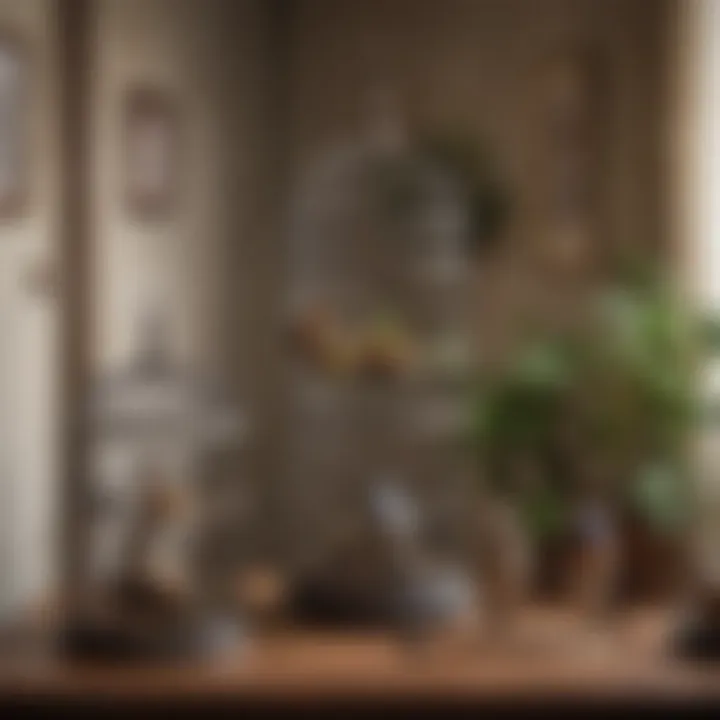
Moreover, incorporating various levels, perches, and platforms within the cage not only promotes physical activity but can significantly reduce boredom, translating to a happier pet.
Attractiveness and Functionality
An attractive cage encourages owners to engage with their birds more frequently, while functionality ensures the well-being and happiness of their avian companions. Striking the right balance between these elements is no small feat; it requires careful consideration of design principles and practical needs.
Choosing Appropriate Materials
When it comes to choosing materials for bird cages, several factors play a crucial role in ensuring the safety and enjoyment of the birds. Stainless steel cages have become a popular choice among bird owners due to their durability and ease of cleaning. Unlike other materials, stainless steel resists rust and does not get porous, which greatly reduces the accumulation of harmful bacteria. This key characteristic makes them not only a beneficial choice but also a long-lasting investment for bird parents who want a low-maintenance option in their care regime.
However, it’s essential to understand that not all metals are suitable for avian habitats. Thus, opting for non-toxic and non-allergenic materials is imperative. Painted or coated cages can also pose risks if the finish contains harmful chemicals, so vigilance is crucial.
Choosing the right materials for your bird's cage is as important as picking the best food; it shapes their quality of life.
Design Considerations for Space
Space is more than just the physical dimensions of the cage—it's about how that space is utilized. A well-thought-out cage design takes into account the bird's natural behavior, such as flying, climbing, and foraging. This means having ample room to stretch wings and legs without feeling cramped.
For many bird species, vertical space is as important as horizontal space due to their natural instinct to perch high. Providing a variety of perch heights enriches their environment, promoting exercise and mental engagement. It's also beneficial to incorporate an area outside the cage where birds can safely explore and interact with their humans. This unique feature of offering a multi-layered cage design not only enhances engagement but helps maintain a bird's physical health, reducing the risk of obesity and related issues.
Ultimately, designing an appropriate space within the cage leads to happier, healthier birds who feel nurtured and loved. Thus, the goal should be to create an environment called home, balancing comfort with the need for exploration.
Enhancing the Owner-Bird Bond
The bond between a bird owner and their avian companion is more than just a fleeting connection. It encompasses a profound understanding that can lead to a harmonious living situation, fostering mutual respect and affection. Enhancing the owner-bird bond is important not only for the emotional well-being of both parties but also for the bird's overall health and behavior. By recognizing and nurturing this bond, one can significantly improve the quality of life for their feathered friend, resulting in a fulfilling companionship.
Understanding Bird Behavior
Birds communicate in ways that can sometimes leave owners scratching their heads. Understanding bird behavior is crucial to building a solid relationship. It involves decoding the myriad signals—both vocal and physical—that birds use to express their thoughts and feelings.
Body Language and Vocalizations
Body language and vocalizations serve as windows into a bird's psyche. Take, for instance, the flapping of wings or the lifting of feathers, which can indicate a range of emotions from excitement to alarm. But it’s not just the actions. The type of sounds—chirps, whistles, or squawking—can communicate everything from happiness to distress.
- Key Characteristics: Birds possess a wide emotional spectrum that they express through their body language and vocalizations.
- Unique Feature: Each species has its unique repertoire of sounds. For example, parrots are famous for their ability to mimic human speech, often forming a charming part of the household.
- Advantages: Recognizing these signals allows owners to respond appropriately, soothing a stressed bird or encouraging playful behavior.
Understanding how to interpret these signs promotes deeper interactions between pet birds and their owners.
Responding to Social Signals
Every bird has its own personality and social needs, which can manifest through specific actions or requests for attention. Responding to social signals can substantially elevate the relationship.
- Key Characteristics: Birds may show signs of wanting attention through specific behaviors like head bobbing or fluttering close to their owner.
- Unique Feature: The social dynamics of different bird species can vary widely; while some may enjoy constant interaction, others might like their space.
- Advantages: By learning to recognize and respond to these social cues, owners can encourage positive behavior, enhancing trust and emotional safety within the bird's environment.
"Just as a well-tuned instrument plays sweet music, understanding bird behavior creates a beautiful harmony between pet and owner."
The Role of Routine in Relationships
Routine acts as a cornerstone in fostering a lasting bond with your avian friend. Birds appreciate predictability, as it translates to security in their world. Establishing a routine contributes to a bird's emotional stability; just as humans thrive on habitual practices, so do birds.
- Daily Interactions: Incorporate consistent playtime, feeding schedules, and brief training sessions. This establishes a rhythm that can be reassuring for both the bird and the owner.
- Variety in Routine: While routines are essential, varying activities can enliven interactions. Introducing new toys, engaging in different play formats, or occasionally changing the scenery maintains interest and stimulates mental agility.
- Social Interaction: Birds are social creatures. Being a part of daily activities, even if just as an observer, strengthens their connection with their owners.
In summary, enhancing the bond with your bird requires understanding behavior, recognizing social signals, and establishing a thoughtful routine. All these elements can lead to a long, rewarding journey together in the metaphorical bird cage that represents freedom and companionship.
Nutritional Considerations
Nutritional needs are at the heart of avian care, often determining how well your feathered companion thrives. A proper diet can reduce health issues, increase lifespan, and promote a full, vibrant life. It's essential for bird owners to recognize the significance of offering a varied and balanced diet tailored to their specific bird species. Every bird is its own little world, with unique requirements based on size, species, and even individual preferences.
The right nutrition doesn’t just keep your bird alive—it influences behavior, plumage quality, and overall happiness. When the diet is lacking, the signs can be subtle yet telling, from changes in vocalizations to shifts in activity levels. This underscores the importance of being attentive and educated about nutritional considerations when bringing a bird into your life.
Exploring Diet Variations by Species
Different bird species have distinct dietary needs, and that’s an understatement. For instance, budgerigars—commonly known as budgies—thrive on a high-energy seed mix enriched with fruits and vegetables, while parrots often require a diet rich in nuts and leafy greens.
Here’s a brief overview:
- Budgerigars: Seed-based diet with occasional fruits and veggies. They enjoy leafy greens like romaine lettuce, carrots, and peas.
- Cockatiels: Similar to budgies, but also need high-quality pellets and can enjoy small amounts of grains.
- Conures: These birds benefit from a mix of fruits like apples and bananas, alongside vegetables and pellets.
- African Grey: Their diet should lean heavily on fruits, vegetables, grains, and high-quality pellets—but be cautious of high-fat content in dried fruit.
Being aware of what your bird's natural diet would look like in the wild can help guide what to provide them in captivity. That’s where species-specific information comes into play. Research and tailor the diet to not just meet basic needs but to also cater to preferences that make feeding time a joy rather than a chore.
Homemade vs. Commercial Food Choices
The ongoing debate about homemade versus commercial bird food choices can leave even seasoned bird owners scratching their heads. Each option has its pros and cons, so weighing them is crucial.
- Homemade Food:
- Commercial Food:
- Pros: You control all ingredients, ensuring freshness, quality, and preventing additives that could be harmful. Plus, it can be more cost-effective if done properly.
- Cons: Requires more time and knowledge about nutritional content. It’s also possible to unintentionally create an unbalanced diet.
- Pros: Convenience is key here. These products are often scientifically formulated to meet the bird's needs. They also save time and guesswork, which some owners find invaluable.
- Cons: Many commercial feeds can contain fillers and preservatives. The quality varies widely, so you must read labels carefully.
When deciding between homemade and commercial options, consider a blend of both. This approach could offer the best of both worlds—nutritional balance and the excitement of fresh food at meal times. Bird owners might also find that their avian friends enjoy foraging for both types of offerings.
"In the world of birds, a thoughtful approach to nutrition is not just a luxury; it's a fundamental pillar of a healthy, long life."
Health and Wellness Monitoring
Monitoring the health and wellness of your avian companion is key to ensuring their longevity and happiness. Just like humans, birds can experience a myriad of health issues that often go unnoticed until they become serious. Regular check-ins on their physical well-being not only prevent potential crises but also play a pivotal role in fostering a nurturing environment. When we take the time to understand the needs of our feathered friends, we create a space where both pet and owner can thrive together.
Recognizing Signs of Distress
Birds are often masterful at hiding their discomfort. This instinctual behavior leaves owners in a precarious position. A sudden change in behavior might indicate an underlying issue. Some common signs of distress include:
- Decreased appetite or eating habits
- Extreme vocalizations or sudden silence
- Changes in feather quality or loss
- Unusual body posturing or difficulty in mobility
Being aware of these symptoms can be the difference between a minor check-up and a serious health intervention. For example, if a bird who normally chirps incessantly becomes silent, it might be their way of signaling a health concern. The earlier these signs are recognized, the quicker the response can be, potentially saving your companion’s life.
Preventative Health Measures
Routine Veterinary Care
Establishing routine veterinary care is a foundation for any successful pet ownership journey. Regular check-ups can help detect illnesses that are often sneaky in their approach. A key characteristic of routine veterinary visits is proactive monitoring. This means that rather than waiting until a bird shows symptoms of illness, owners can take preemptive steps to ensure ongoing health.
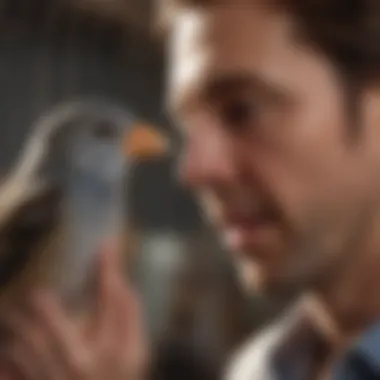
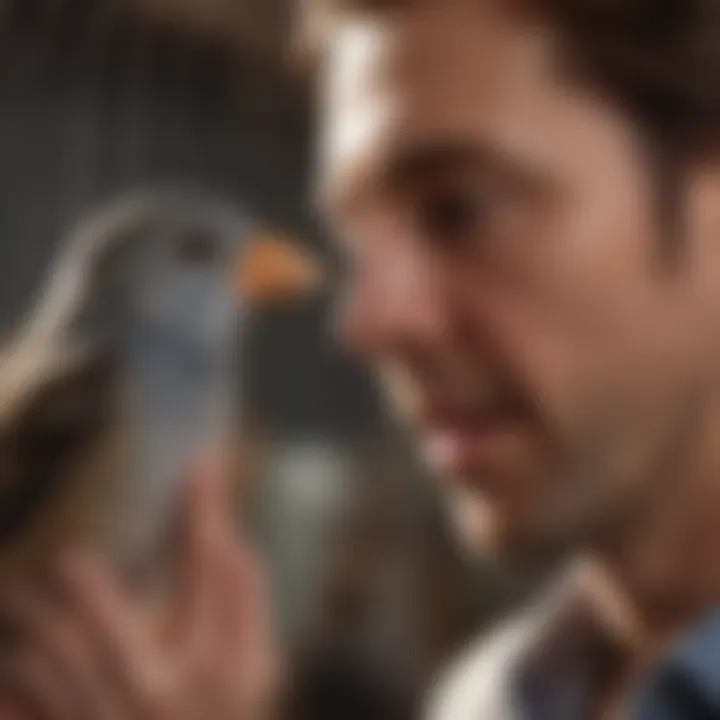
The uniquness of routine veterinary care lies in its tailored approach. Avian veterinarians can provide insights that are specifically relevant to the species of your bird. This eliminates the guesswork often involved in general pet care. The advantages of such specialized care include personalized dietary recommendations and vaccinations when necessary, protecting your bird from common ailments while maintaining overall wellness.
Environmental Factors Impacting Health
The environment in which a bird lives significantly impacts its health. Proper ventilation, temperature control, and cleanliness are among the major environmental factors that should not be overlooked. For a bird's housing, a good rule of thumb is to regularly clean cages, replace bedding, and avoid exposure to drafts.
One of the primary characteristics of a healthy environment is that it reduces stressors that can lead to illness. The light and air quality, along with the type of materials used in the cage, can contribute to or detract from a bird's overall health. Unique features such as providing natural perches and avoiding chemicals in cleaning supplies can have tremendous advantages, leading to happier, more resilient birds.
As you delve into the complexities of avian care, recall the crucial bond that forms between a healthy environment and a well-monitored companion. These factors work hand in hand to ensure both bird and owner enjoy their shared space to the fullest. In essence, a proactive approach to health and wellness monitoring can transform your relationship, elevating it from mere companionship to a lifelong partnership filled with mutual understanding.
Enrichment Activities for Engagement
Engaging a pet bird goes beyond just feeding and housing them. Enrichment activities play a crucial role in ensuring the mental and physical well-being of avian companions. These activities are not merely fun distractions; they stimulate a bird's brain and help to recreate some of the challenges they would encounter in the wild. Much like keeping a child occupied with toys and games, these activities can prevent boredom and, ultimately, undesirable behaviors stemming from it. Creating a rich environment filled with engaging activities fosters a more fulfilling relationship between bird and owner.
Mental Stimulation Techniques
Utilizing mental stimulation techniques involves training exercises, puzzles, and other activities that genuinely engage your bird’s cognitive abilities. Regularly challenging the bird's mind can make a noticeable difference in its overall demeanor. Here are a few effective techniques:
- Puzzle Feeders: Hiding food or treats in puzzle feeders requires a bird to figure out how to get to the goodies, mimicking natural foraging behavior.
- Training Sessions: Teaching tricks not only entertains but also provides the bird with a sense of accomplishment. Birds often enjoy learning new things.
- Interactive Learning Toys: These toys often involve multiple parts that require manipulation, making them appealing and mentally taxing for an animal that thrives on active engagement.
Mental stimulation shouldn't be considered a luxury, but a necessity for a thriving pet bird's lifestyle. Without regular challenges, birds can become stressed or depressed, leading to feather plucking or loud vocalizations. Thus, opening new avenues for exploration can do wonders.
Physical Activity and its Importance
Physical activity is just as critical as mental engagement for birds. These creatures are naturally active and energetic, requiring opportunities to move about, climb, and stretch their wings. Providing avenues for physical activities contributes to their overall health.
Interactive Playtime
Interactive playtime invites the owner to join in on the fun, and it magnifies the bonding experience between bird and human. Flying around the room or playing games with toys like ladders or swings can invigorate even the shyest of birds. However, this activity isn't merely about having fun—it's geared towards maintaining the bird's physical fitness. Also, it can be a sociable time when the bird learns to trust its owner more.
A key characteristic of interactive playtime is its inclusiveness; it's not just about the bird having fun alone but sharing experiences. Regularly scheduled play allows the bird to exercise its wings, practice agility, and enjoy the companionship of its owner. However, some owners may find it challenging to keep the bird entertained, which can sometimes lead to feeling frustrated if the bird seems uninterested.
Ball and Toy Varieties
Providing a variety of balls and toys brings joy and excitement into a pet bird’s life. Birds are often curious and love to investigate new objects. Each type of toy serves a particular purpose, from chewing to climbing and playing fetch. Toys made from different materials—like wood, plastic, or natural fibers—offer distinct textures that can attract a bird’s attention.
The key benefit of introducing various balls and toys lies in their multifunctionality. Some allow birds to chew safely, while others aid in honing their motor skills. Toy variety keeps the environment fresh and exciting for the bird, which can prevent boredom and encourage active exploration.
However, too many toys can sometimes overwhelm a bird or lead to indecision on what to play with. Hence, it's best to rotate toys regularly to maintain interest.
Encouraging both mental stimulation and physical activity through these enrichment activities creates a harmonious environment where the bird can thrive. By understanding your companion’s needs, you can significantly enhance their quality of life in your metaphorical bird cage.
Navigating Behavioral Challenges
Navigating behavioral challenges in pet birds is crucial for fostering a harmonious relationship between the bird and its owner. These challenges can stem from various factors, including environmental changes, lack of mental stimulation, or stress from being in a confined space. Owners must understand and address these issues proactively to ensure the well-being of their avian companions. A strong grasp of avian behavior can not only resolve conflicts but also enhance the bond that one shares with their pet.
Common Misconceptions About Bird Behavior
Birds are often mischaracterized due to misunderstandings about their behavior and communication. For example, many people believe that a bird that chirps constantly is unhappy or seeks attention, yet this can be a sign of contentment or even playfulness. Similarly, a parrot that “talks back” can be dismissed as rude or rebellious, when in fact it might simply be mimicking its owner or trying to engage. It’s essential to realize that birds, like any pet, express a wide range of emotions through their actions.
Some of the misconceptions include:
- Birds don’t need socialization: Many assume birds can be solitary. However, most bird species thrive on interaction, both with their owners and other birds.
- Aggression is normal: Aggression in birds is often misread. It can stem from fear or a need to establish boundaries rather than just a 'bad attitude'.
- Birds are low-maintenance pets: While they are lovely to have, birds require consistent attention and engagement to flourish.
Understanding these misconceptions allows for more empathetic care and helps in developing effective strategies for interaction.
Implementing Positive Reinforcement Strategies
Positive reinforcement is a crucial technique in addressing behavioral challenges in birds. It is based on the principle of rewarding desired behaviors to encourage their repetition. Here’s how to effectively apply this approach:
- Identify Triggers: Observe the bird’s behavior to find out what actions lead to desired outcomes. Knowing what excites or calms your bird can help streamline your training efforts.
- Use Treats Wisely: Select healthy, species-appropriate treats that can be offered as rewards. This could be a small piece of fruit or even millet. The key is to make the treat appealing enough that the bird associates the behavior with something positive.
- Session Timing: Keep training sessions short but frequent. Birds often have brief attention spans, so concise sessions can yield better results.
- Consistency is Key: Everyone in the household must use the same commands and reward systems. This uniformity helps the bird learn more effectively.
Applying these principles not only improves behavior but also fosters trust between the bird and owner. Through patience and a solid understanding of positive reinforcement, any owner can help their feathered friend thrive in their shared environment.
"Birds are not just pets; they're companions that can teach us about communication and trust. Let’s show them the same compassion they show us."
By confronting these behavioral challenges head-on and focusing on clear communication and respectful interaction, both owners and birds can enjoy a closer and more fulfilling companionship.
The Long-Term Commitment to Bird Care
When it comes to sharing your life with a pet bird, it’s vital to understand that this relationship is not something you can take lightly. It stretches beyond fleeting moments of joy and laughter; it is a profound commitment. Birds can live long lives—many parrot species, for instance, can reach ages of 30 years or more in captivity. Thus, realizing the full extent of your commitment is crucial. In this section, we will scrutinize the intricacies of caring for your feathered companions over the long term, emphasizing the essential aspects of their care needs and the life changes that may arise along the way.
Understanding Lifespan and Care Needs
Birds have remarkably diverse lifespans based on their species, and this factor affects their care requirements immensely. An understanding of these needs isn’t just beneficial; it's essential for nurturing a healthy and thriving companion. In essence, you must fine-tune your lifestyle to accommodate your feathered friend.
- Dietary Requirements: A balanced diet tailored to a specific species is non-negotiable. For example, a budgie’s diet differs significantly from a macaw's. You need to grasp the nutritional nuances, ensuring they receive the right vitamins, minerals, and variety—think fresh fruits, vegetables, and specialized pellets.
- Social Interaction: Birds are inherently social creatures. They need daily interaction, both human and potentially avian, to flourish emotionally. Fostering social activity helps prevent behavioral issues and encourages a harmonious relationship.
- Cage Space & Environment: Each species has unique space requirements. A larger bird may necessitate a more expansive enclosure than a smaller one. The cage should ideally mimic their natural habitat to a certain extent, promoting exercise and mental stimulation.
- Health Maintenance: Regular veterinary check-ups are a must. Unlike dogs or cats that might show clear signs of distress, birds often hide their symptoms. It’s beneficial to cultivate an attentive eye for subtle behavioral changes.
Understanding these elements can reshuffle your priorities entirely. It highlights that buying a bird isn't simply adding a pet to your home; it’s akin to welcoming a family member who will require your time, attention, and dedication for years, possibly decades to come.
Planning for Life Changes
Life, as unpredictable as a windy day, brings with it changes—some welcome, some not so much. Adapting your plans to account for life changes is an important consideration when committing to bird ownership. Here are a few scenarios you might encounter:
- Relocation: Moving to a new home may require re-evaluating your bird’s space. Ensure your new living environment meets their needs, otherwise, you might end up needing to adjust their cage setup or even consider rehoming.
- Family Dynamics: The arrival of children or new family members should factor into your bird care. Birds can sometimes feel neglected or stressed with the upheaval, so preparation is key to maintain their wellbeing.
- Work Schedule Adjustments: A new job or increased work hours might mean changes to your daily interactions with your bird. Planning regular bonding time becomes essential to keep the relationship intact.
- Health Considerations: Your own health issues may affect your ability to care for your bird. Always consider what happens if you're unable to provide the required attention—arranging for trusted pet sitters or family members should be part of this planning.
"A pet bird teaches you about the rhythm of life—both its predictable beats and its unexpected crescendos. The real question is, are you ready for the duet?"
Being prepared for these possibilities isn't merely a suggestion; it’s a vital part of ensuring that you and your avian partner maintain a stable, rewarding relationship throughout the years. Ultimately, being a responsible bird owner means planning for not just the joys of the present, but also for the uncertainties of the future.
Finale: The Interconnectedness of Bird and Owner
The bond formed between a pet bird and its owner can be as intricate and layered as the fabric of life itself. When one takes a moment to reflect on this relationship, it becomes clear that it’s not merely defined by the act of care or companionship, but rather a dynamic interplay that enhances both lives involved. This connection is transformative, reshaping the perceptions and attitudes of the owner while granting the bird a fulfilling environment in which to thrive.
Reflecting on the Journey Together
Every bird owner embarks on a journey that is both rewarding and challenging. As you nurture your feathered friend, you also undergo growth. Often, the growth is subtle; a realization that your parrot reacts to your mood when you walk into a room, or how a canary's song can elevate your spirits on a dull day. These moments underscore a critical point: the emotional contributions of each party. The act of caring, from daily routines to specialized feeding, becomes a rhythm that the two share.
Reflecting on this journey, we must consider how the relationship changes with time. When a chick first comes into your life, it may rely on you heavily for everything. However, as it matures and begins to engage more fully, you may find it imparts happiness, companionship, and even lessons about freedom and expression. Engaging in activities that bolster your connection—like teaching tricks or exploring different social settings—fosters mutual growth. In this way, the journey taken together becomes a tapestry woven from shared experiences and discoveries.
Fostering a Truly Nurturing Environment
Creating an environment that fosters this interconnectedness requires thoughtful attention to a range of factors. Consider both the visible and invisible aspects of home life that can impact your bird’s well-being. A nurturing environment isn't just about a spacious cage or an assortment of toys; it should be a place where your bird feels secure, loved, and stimulated.
- Physical Space: The arrangement of your bird’s cage, the types of perches available, and the layout of the room all play a role. Birds are naturally curious creatures; providing an accessible area for them to explore can significantly enhance their quality of life.
- Social Interaction: Birds thrive on interaction—not just with other birds but with their human companions. Regular hands-on engagement, like playtime, speaks volumes about your commitment and can alleviate feelings of loneliness.
- Routine: Establishing a routine provides a sense of stability. Birds, much like humans, thrive on predictability. Each feeding and play session can serve as a bridge that strengthens your bond.
- Mental Enrichment: Activities such as foraging, puzzle toys, or basic training can stimulate their minds. A engaged bird is a happy bird, and happy birds tend to behave better and show more affection.
Cultivating an atmosphere that embodies love, safety, and mental stimulation encourages your bird to express its unique personality. When both parties are comfortable in their respective roles within the cage, the bond deepens, leading to habits of mutual respect and fulfillment.
In essence, the journey of bird ownership transcends mere companionship; it becomes a fundamental lesson in understanding, care, and emotional investment. Through maintaining this interdependence, the connection between bird and owner reveals itself as a dance—an intricate choreography where both parties learn and grow together.















